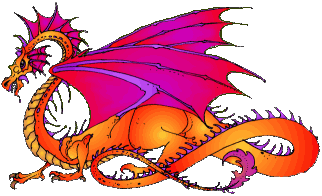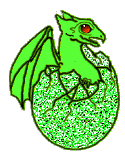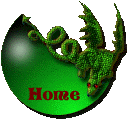Where the dragons dwell
 Dragon, a legendary reptilian monster similar in form to a crocodile and usually represented as having wings, huge claws, and a fiery breath. In some folklore of antiquity, the dragon symbolizes destruction and evil. This conception is found, for example, in Enuma Elish, a Mesopotamian creation epic written about 2000 BC. One of the central figures of the legend is the goddess Tiamat, a dragonlike personification of the oceans, who headed the hordes of chaos and whose destruction was prerequisite to an orderly universe. In the sacred writings of the ancient Hebrews, the dragon frequently represents death and evil. Christianity inherited the Hebraic conception of the dragon, which figures in all the important apocalyptic literature of the Bible, notably in Revelation, and appears in later Christian traditions. In Christian art, the dragon is a symbol of sin. It is often represented as crushed under the feet of saints and martyrs, symbolizing the triumph of Christianity over paganism.
Dragon, a legendary reptilian monster similar in form to a crocodile and usually represented as having wings, huge claws, and a fiery breath. In some folklore of antiquity, the dragon symbolizes destruction and evil. This conception is found, for example, in Enuma Elish, a Mesopotamian creation epic written about 2000 BC. One of the central figures of the legend is the goddess Tiamat, a dragonlike personification of the oceans, who headed the hordes of chaos and whose destruction was prerequisite to an orderly universe. In the sacred writings of the ancient Hebrews, the dragon frequently represents death and evil. Christianity inherited the Hebraic conception of the dragon, which figures in all the important apocalyptic literature of the Bible, notably in Revelation, and appears in later Christian traditions. In Christian art, the dragon is a symbol of sin. It is often represented as crushed under the feet of saints and martyrs, symbolizing the triumph of Christianity over paganism.
In certain mythologies, the dragon is more generally credited with beneficent powers. The ancient Greeks and Romans believed that dragons had the ability to understand and to convey to mortals the secrets of the earth. Partially as a result of this conception of the monster as a benign, protective influence, and partially because of its fearsome qualities, it was employed as a military emblem. The Roman legions adopted it in the first century AD, inscribing the figure of a dragon on the standards carried into battle by the cohorts. The folklore of the pagan tribes of northern Europe contained both beneficent and terror-inspiring dragons. In the Nibelungenlied, Siegfried kills a dragon, and one of the principal episodes of Beowulf deals with a similar achievement. The ancient Norsemen adorned the prows of their vessels with carved likenesses of dragons. Among the Celtic conquerors of Britain the dragon was a symbol of sovereignty. The legendary monster was also depicted on the shields of the Teutonic tribes that later invaded Britain, and it appeared on the battle standards of the English kings as late as the 16th century. Beginning in the early 20th century, it was inscribed on the armorial bearings of the prince of Wales.
The dragon also figures in the mythology of various Oriental countries, notably Japan and China. It is deified in the Taoist religion and was the national emblem of the Chinese Empire. Among the Chinese people, the dragon is traditionally regarded as a symbol of good fortune.
 Characterics of Dragons:
Characterics of Dragons:
The Horned Dragon
The most powerful of the Oriental Dragons, also called Lung. They can produce rain are are totally deaf.
The Winged Dragon
The only flying Oriental Dragon.
The Celestial Dragon
Believed to support and protect the mansions of the Gods.
The Spiritual Dragon
Generate wind and rain for the benefit of mankind.
The Dragon Of Hidden Treasures
Keepers of concealed wealth.
The Coiling Dragon
Water dragons who live mostly in the lakes of the Orient.
The Yellow Dragon
Who emerged from the water and gave the Emperor Fu Hsi with the knowledge of writing.
The Dragon King
A group of dragons who individually rule over the four seas divided by the celestial directions, North, South, East and West.
These Oriental dragons can be found in a variety of colors. Of the three Neodracos these are the most colorful. Reaching up to 40-50 feet in length, their scales shimmer like silver, blue, green, red or combination of all these. Like the European and American dragons the Oriental dragons are primarily nocturnal. But this breed of dragon does venture out in daylight hours, especially in Spring.
Dragon Poem
On the island
known as Qwell
There you'll find
where the dragons dwell
 From the time of birth
From the time of birth
growing ever so steady
you want to watch them
but are you really ready?
The winged kind
flying through the air
breathing fire
without despair
IF only for a moment
a glimpse of them to see
would bring much fascination
and imaginations would come to be
The dragon is hated by some
and feared by many
but why is this?
have you ever seen any?
With scaley bodies
and nostrils wide
I want to see them
and catch a ride
I want to soar
upon their backs
and open a new world
of things this one lacks
Give me the dragon
For I am neither friend nor foe
I want to learn
I want to know.
© by L.C. White
Reference and Resources:
Branston, Brian. ~ Gods of the North ~ (Thames & Hudson, 1980).
Cotterell, Arthur. ~ A Dictionary of World Mythology ~ (Oxford Univ. Press,1986).
Daley, K.N. ~ Norse Mythology A to Z ~ (Facts on File, 1991).
Davidson, H.R.E. ~ Gods and Myths of Northern Europe ~ (Penguin, 1964).
Grimal, Pierre, ed. Larousse ~ World Mythology ~ (Chartweil, 1965).
Hatto, A.T., trans. ~ Nibelungenlied ~ (Penguin, 1965). Hollander, L.M., trans. ~ Poetic Edda ~ , 2nd ed., rev. (Univ. of Texas Press,1962).
Johnsgard, Paul & Karin, ~ A Natural History 'Dragons and Unicorns ~ (St. Martins Press, 1982) Mercatante, A.S. ~ Encyclopedia of World Mythology and Legend ~ (Facts on File, 1988). Sturluson, Snorri. ~ Edda ~ (J.M. Dent & Sons, 1987). Sturluson, Snorri. ~ The Prose Edda: Tales from Norse Mythology ~ (Univ. ofCalif. Press, 1971).
Sykes, Egerton. ~ Who's Who in Non-Classical Mythology ~ , rev. ed. (Oxford Univ.Press, 1993).
Dragon Links
Dragons HOmepageHere be the Dragons
